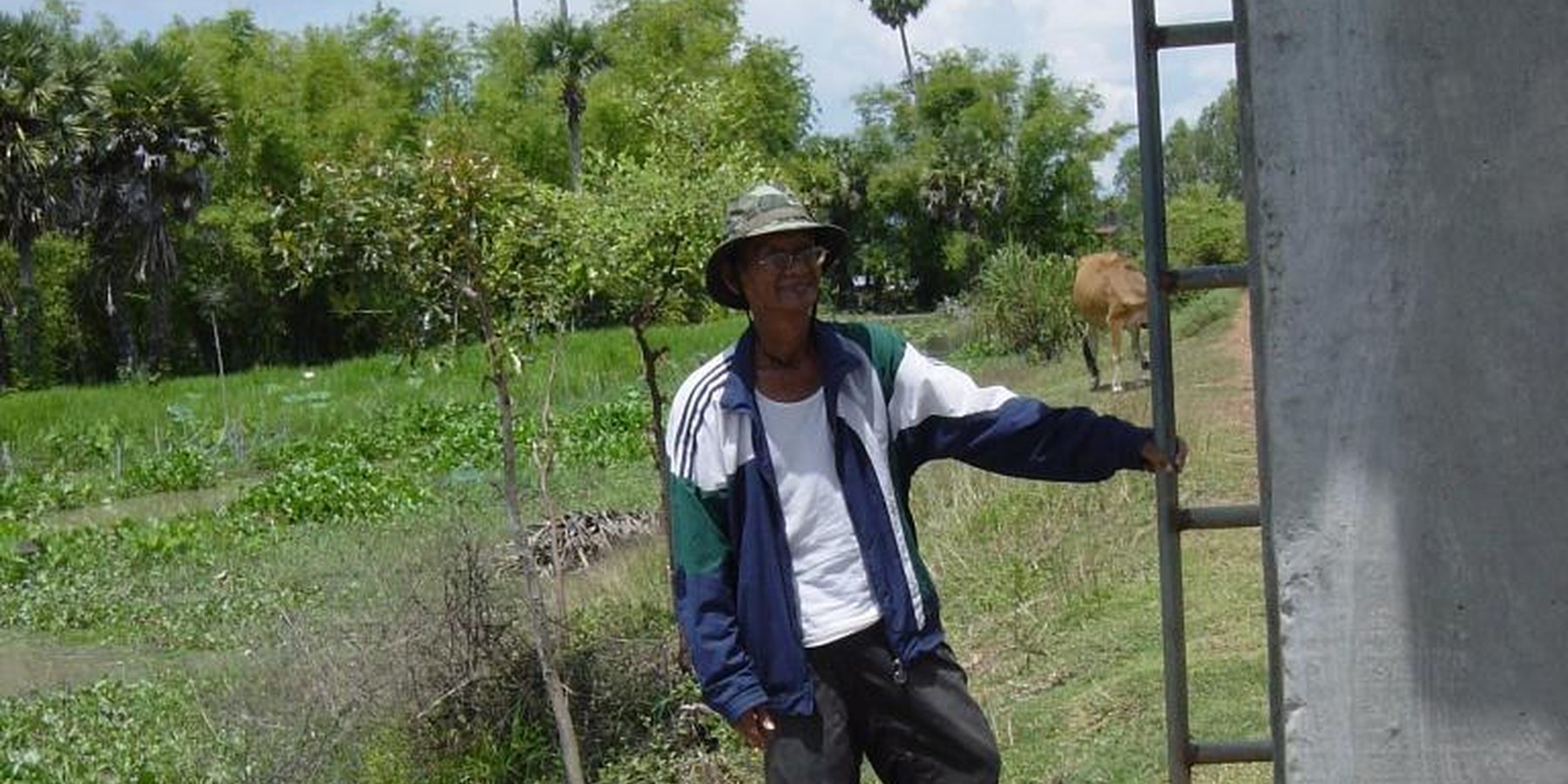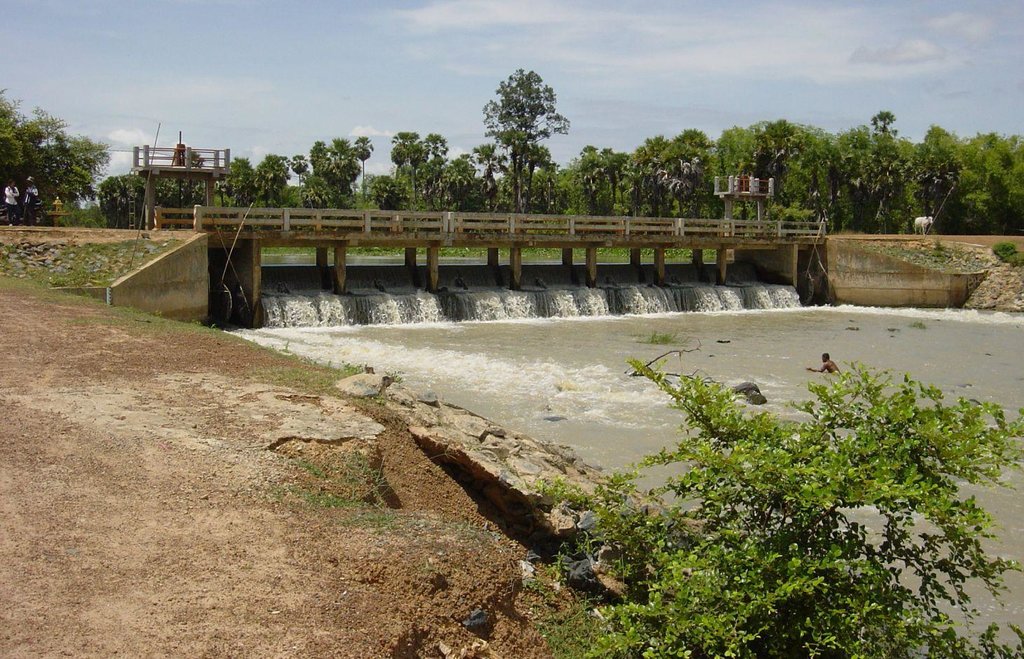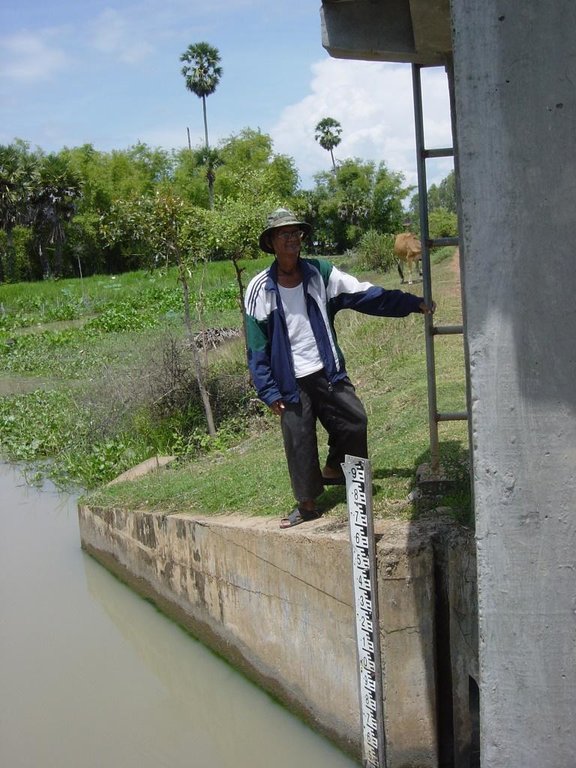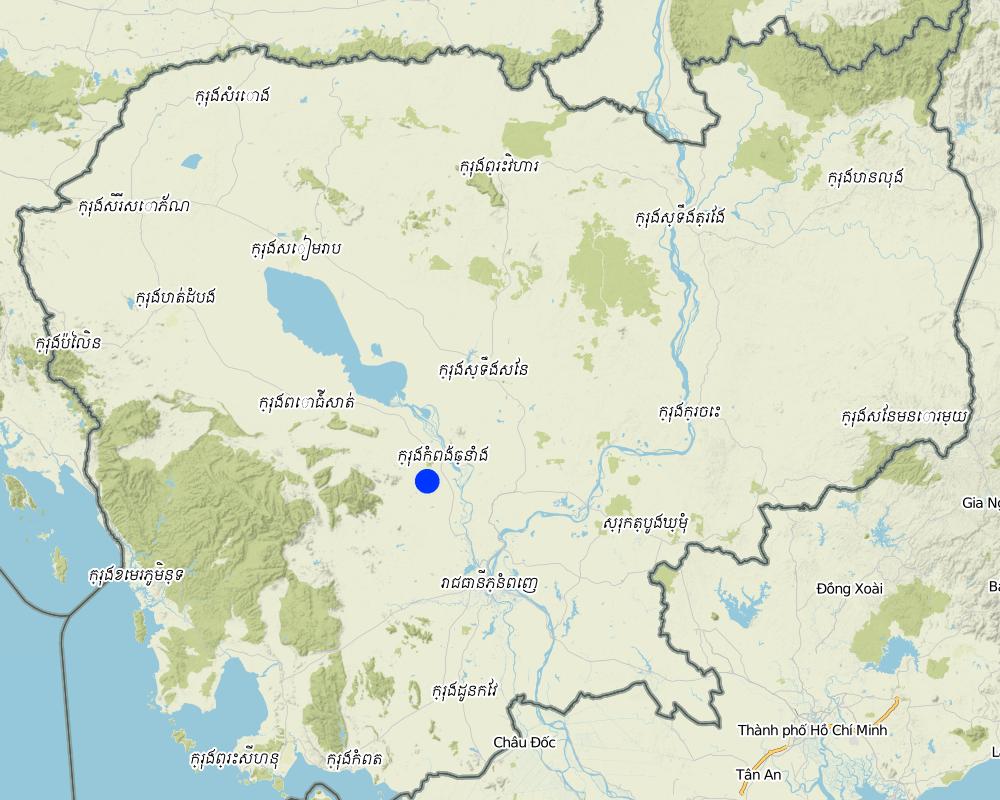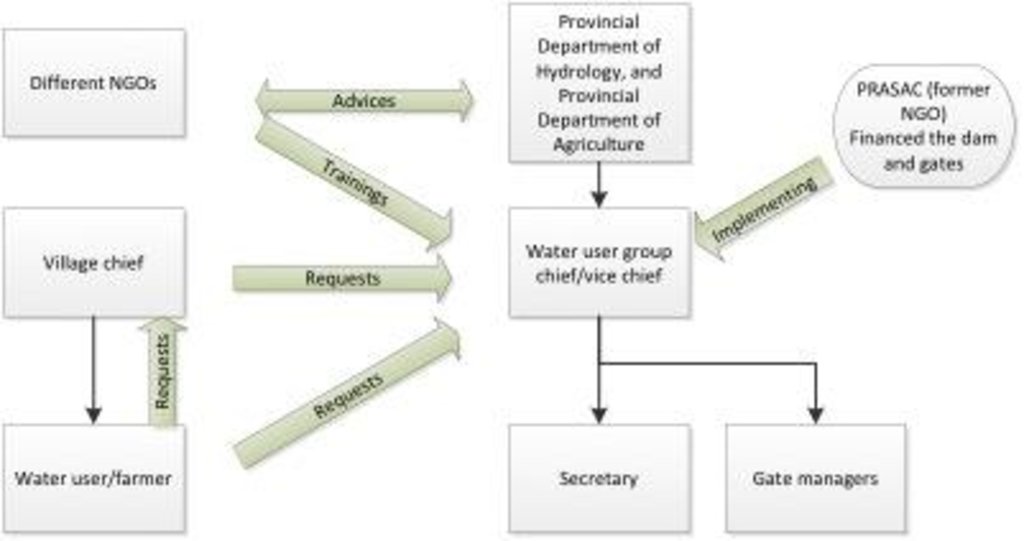Water user group [Cambodia]
- Creación:
- Actualización:
- Compilador: Stefan Graf
- Editor: –
- Revisor: David Streiff
ក្រុមប្រើប្រាស់ទឹក (Khmer)
approaches_2595 - Cambodia
Visualizar secciones
Expandir todo Colapsar todos1. Información general
1.2 Detalles de contacto de las personas de referencia e instituciones involucradas en la evaluación y la documentación del Enfoque
Especialista MST:
Pith Khonhel
Local Agriculture Research and Extension Centre LAREC
Cambodia
Especialista MST:
Bin Sreytouch
Society for Community Development in Cambodia SOFDEC
Especialista MST:
Khun Lean Hak
kleanghak@yahoo.com / sofdec@camintel.com
SOFDEC/LAREC
Cambodia
Nombre de la(s) institución(es) que facilitaron la documentación/ evaluación del Enfoque si fuera relevante)
Society for Community Development in Cambodia (SOFDEC) - CambodiaNombre de la(s) institución(es) que facilitaron la documentación/ evaluación del Enfoque si fuera relevante)
Local Agricultural Research and Extension Centre (LAREC) - Cambodia1.3 Condiciones referidas al uso de datos documentados mediante WOCAT
¿Cuándo se compilaron los datos (en el campo)?
09/09/2014
El compilador y la/s persona(s) de referencia claves aceptan las condiciones acerca del uso de los datos documentados mediante WOCAT :
Sí
1.4 Referencia/s al/los Cuestionario(s) de Tecnologías MST
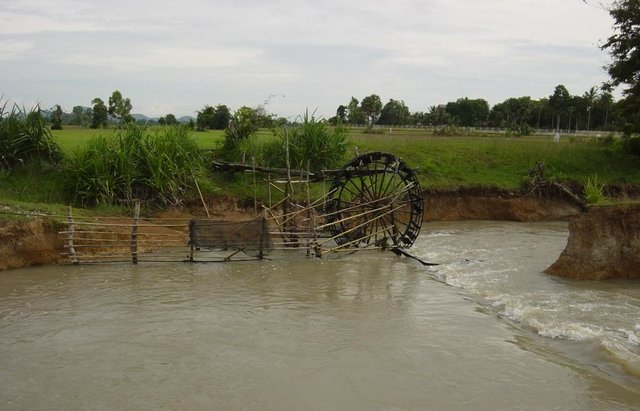
Irrigation of paddy fields using water-pumping wheels (Norias) [Cambodia]
Norias are water-pumping wheels made of bamboo which are used to irrigate paddy fields in order to increase the yield.
- Compilador: Christoph Kaufmann
2. Descripción del Enfoque MST
2.1 Breve descripción del Enfoque
A water user group, led by a committee staff, decides about the distribution of the water during the dry season to plant dry season rice.
2.2 Descripción detallada del Enfoque MST
Descripción detallada del Enfoque MST:
Aims / objectives: During the Pol Pot regime, a dam was built to catch and store water from a temporary stream to irrigate rice during the dry season. The dam degraded over time, therefore it was repaired by a NGO to provide water for the cultivation of dry season rice. To manage it, a water user group was formed. The aim of this water user group is to have a fair distribution of the water hold by the dam among the farmers located downstream. The water user group is led by an elected committee staff of 5 members, who are the direct contact persons for the individual farmers and village chiefs, as well as for the provincial department of hydrology.
Methods: A former local NGO, PRASAC (now a microfinance institute), which repaired the dam and gates, organised a meeting with the three concerned villages to elect a committee responsible for the management of the water. The committee, consisting of a chief, a vice-chief, a secretary and an accounting, and two managers of the gates (each responsible for one gate) is responsible for the fair distribution of the water. The chief is the contact person for the village chiefs or the farmers themselves, who can request water. He is the contact person for the provincial department of hydrology as well.
Stages of implementation: The water user group was elected in 2002, when the dam was fixed. A short training was given to the committee which was then left on its own for the management. After tensions that occurred between farmers, the committee asked for advice in the provincial department of hydrology, which was passed off to CDRI (Cambodia Development Resource Institute), a local NGO. The CDRI conducted meetings and acted as a mediator, since then no tensions occurred anymore between water users as they introduced weekly schedules.
Role of stakeholders: The chief and vice chief are responsible for the distribution of the water. The two gate managers are controlling the gates.
2.3 Fotos del Enfoque
2.5 País/ región/ lugares donde el Enfoque fue aplicado
País:
Cambodia
Región/ Estado/ Provincia:
Kampong Chhnang
Especifique más el lugar :
Toeuk Phos
Comentarios:
A bit more than 100 ha are irrigated under this approach.
Map
×2.6 Fechas de inicio y conclusión del Enfoque
Indique año del inicio:
2002
Año de conclusión (si el Enfoque ya no se aplica):
2003
2.7 Tipo de Enfoque
- proyecto/ basado en un programa
2.8 Propósitos/ objetivos principales del Enfoque
The Approach focused on SLM only
A fair distribution of water among the farmers, to produce rice during the dry season as well.
The SLM Approach addressed the following problems: The approach was designed to avoid conflicts on the use of water resources, and to allow rice production during the dry season.
2.9 Condiciones que facilitan o impiden la implementación de la/s Tecnología/s aplicadas bajo el Enfoque
disponibilidad/ acceso a recursos y servicios financieros
- impiden
The staff works on a voluntary basis.
Treatment through the SLM Approach: The gate managers catch fish at the gates while releasing water which provides an income. The chief records the water levels behind the dam for the provincial department of hydrology, which provides an income to him.
marco de trabajo legal (tenencia de tierra, derechos de uso de tierra y agua)
- impiden
Conflicts between farmers about water use. The lower villages did not get enough water.
Treatment through the SLM Approach: A NGO, CDRI, acted as a mediator in the conflict. Since then no more tensions occurred as they introduced weekly schedules.
The existing land ownership, land use rights / water rights hindered a little the approach implementation Before there was open access to water, but no water was available since the dam was broken. Now there is water, but it is regulated.
3. Participación y roles de las partes interesadas involucradas
3.1 Partes interesadas involucradas en el Enfoque y sus roles
- usuarios locales de tierras/ comunidades locales
Villagers and village chiefs
The operation of the water gates needs a strong physical condition. The literacy of women is lower than the one of men. Only male staff.
Poor people were also involved, and use the water.
- especialistas MST/consejeros agrícolas
- ONG
PRASAC implemented the water user group.
- gobierno nacional (planificadores, autoridades)
Provincial department of hydrology
3.2 Involucramiento de los usuarios locales de tierras/ comunidades locales en las distintas fases del Enfoque
| Involucramiento de los usuarios locales de tierras/ comunidades locales | Especifique quién se involucró y describa las actividades | |
|---|---|---|
| iniciación/ motivación | ninguno | |
| planificación | ninguno | |
| implementación | pasivo | The committee was elected, and acts until today. |
| monitoreo y evaluación | ninguno | |
| Research | ninguno |
3.3 Flujograma (si estuviera disponible)
Descripción:
Organogram of the different stakeholders in the water user group in Toeuk Phos.
Autor:
Stefan Graf (Centre for Development and Environment)
3.4 La toma de decisiones en la selección de Tecnología(s) MST
Especifique quién decidió la selección de las Tecnología/ Tecnologías a implementarse:
- solo por especialistas MST
Explique:
The former NGO, PRASAC, fixed the dam that was constructed during the Pol Pot regime. The farmers had to be persuaded to plant dry season rice.
Decisions on the method of implementing the SLM Technology were made by by SLM specialists alone (top-down). The NGO decided that the water user group should be managed that way, organised an election and the same staff works since then.
4. Apoyo técnico, fortalecimiento institucional y gestión del conocimiento
4.1 Construcción de capacidades / capacitación
¿Se proporcionó la capacitación a usuarios de tierras/ otras partes interesadas?
Sí
Especifique quién fue capacitado:
- usuarios de tierras
- personal de campo/ consejeros
Forma de capacitación:
- en el contexto de trabajo
- áreas de demostración
Temas avanzados:
Growing of dry season rice. The Provincial Dept. of Agriculture rented 100 ha and planted dry season rice. Since then the farmers plant it by themselves.
The staff was trained to work alone managing the water gates.
4.2 Servicio de asesoría
¿Los usuarios de tierras tienen acceso a un servicio de asesoría?
Sí
Especifique si servicio proporcionado se realizó:
- en centros permanentes
Describa/ comentarios:
In case the chief is confronted with a problem, he approaches the Provincial Department of Agriculture. The chief is then either redirected to a NGO or gets help by the Provincial Department of Agriculture.
Advisory service is inadequate to ensure the continuation of land conservation activities; The committee staff provides the water for free, the maintenance costs have to be financed by the provincial dept. of hydrology. PRASAC provided a financial reserve for the maintenance somewhere in the government, but neither the water user group chief nor the secretary/accountant know where this account is.
4.3 Fortalecimiento institucional (desarrollo institucional)
¿Se establecieron o fortalecieron instituciones mediante el Enfoque?
- no
4.4 Monitoreo y evaluación
¿El monitoreo y la evaluación forman parte del Enfoque?
Sí
Comentarios:
Bio-physical aspects were regular monitored by project staff through measurements; indicators: Water level is monitored daily by committee chief, data reported to provincial dept. of hydrology.
There were few changes in the Approach as a result of monitoring and evaluation: Weekly schedules were established to avoid conflicts between villages. CDRI was working as a mediator.
There were no changes in the Technology as a result of monitoring and evaluation
4.5 Investigación
¿La investigación formó parte del Enfoque?
No
5. Financiamiento y apoyo material externo
5.1 Presupuesto anual para el componente MST del Enfoque
Comentarios (ej. fuentes principales de financiamiento/ donantes principales):
Approach costs were met by the following donors: national non-government (PRASAC): 100.0%; local community / land user(s) (Staff consists of volunteers )
5.2 Apoyo financiero/material proporcionado a los usuarios de tierras
¿Los usuarios de tierras recibieron financiamiento/ apoyo material para implementar la Tecnología/ Tecnologías? :
No
5.3 Subsidios para insumos específicos (incluyendo mano de obra)
- infraestructura
| Especifique qué insumos se subsidiaron | En qué grado | Especifique los subsidios |
|---|---|---|
| Dam and gates | totalmente financiado | |
Si la mano de obra de usuarios de tierras fue un insumo sustancial, ¿fue:
- voluntario?
Comentarios:
the water user group staff works for free.
5.4 Crédito
¿Se proporcionó crédito bajo el Enfoque para actividades MST?
No
6. Análisis de impacto y comentarios de conclusión
6.1 Impactos del Enfoque
¿El Enfoque ayudó a los usuarios de tierras a implementar y mantener Tecnologías MST?
- No
- Sí, un poco
- Sí, moderadamente
- Sí, mucho
They are able to produce food during the whole year, with up to 3 rice harvests a year on the same fields.
¿El Enfoque empoderó a grupos en desventaja social y económica?
- No
- Sí, un poco
- Sí, moderadamente
- Sí, mucho
Landless farmers have more work, as 3 rice harvests are produced per year.
¿El Enfoque mejoró cuestiones de tenencia de tierra/ derechos de usuarios que obstaculizaron la implementación de la Tecnologías MST?
- No
- Sí, un poco
- Sí, moderadamente
- Sí, mucho
According to the committee chief, no more tensions occur now.
Did other land users / projects adopt the Approach?
- No
- Sí, un poco
- Sí, moderadamente
- Sí, mucho
A fourth village joined the water user group.
Did the Approach lead to improved livelihoods / human well-being?
- No
- Sí, un poco
- Sí, moderadamente
- Sí, mucho
The technology (the dam with gates) helped. But it would not work without the approach. It improved the food production, thus food security, and the livelihoods of the farmers.
Did the Approach help to alleviate poverty?
- No
- Sí, un poco
- Sí, moderadamente
- Sí, mucho
It helped to alleviate poverty among the farmers owning land in the irrigated areas as they can produce more.
6.2 Motivación principal del usuario de la tierra para implementar MST
- producción incrementada
Three harvests instead of only one.
- well-being and livelihoods improvement
Three harvests instead of only one.
6.3 Sostenibilidad de las actividades del Enfoque
¿Pueden los usuarios de tierras sostener lo que se implementó mediante el Enfoque (sin apoyo externo)?
- incierto
Si respondió no o incierto, especifique y comente:
It is unclear what would happen if the dam needs maintenance but the provincial dept. of hydrology would not be willing to pay the maintenance costs.
6.4 Fortalezas/ ventajas del Enfoque
| Fuerzas/ ventajas/ oportunidades desde la perspectiva del usuario de la tierra |
|---|
|
Improved livelihoods, three times more rice production and water vegetables as well as fish during the whole year. |
| No pumps are needed. |
| Farmers help each other with the water. (How to sustain/ enhance this strength: Regular meetings. ) |
6.5 Debilidades/ desventajas del Enfoque y formas de sobreponerse a ellos
| Debilidades/ desventajas/ riesgos desde la perspectiva del usuario de la tierra | ¿Cómo sobreponerse a ellas? |
|---|---|
| There is no money for maintenance activities. | |
| Nobody wants to work as committee staff as they don’t get any salary for this work. |
| Debilidades/ desventajas/ riesgos desde la perspectiva del compilador o de otra persona de referencia clave | ¿Cómo sobreponerse a ellas? |
|---|---|
|
No regular elections, nor bottom up improvements. Everything comes from outside. |
7. Referencias y vínculos
7.1 Métodos/ fuentes de información
- visitas de campo, encuestas de campo
- entrevistas con usuarios de tierras
Vínculos y módulos
Expandir todo Colapsar todosVínculos

Irrigation of paddy fields using water-pumping wheels (Norias) [Cambodia]
Norias are water-pumping wheels made of bamboo which are used to irrigate paddy fields in order to increase the yield.
- Compilador: Christoph Kaufmann
Módulos
No se hallaron módulos


